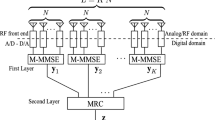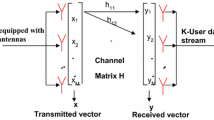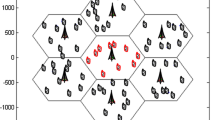Abstract
This paper is on the resource allocation problem for pilot-assisted multi-user massive multiple-input-multiple-output (MIMO) uplink with linear minimum mean-squared error (MMSE) channel estimation and detection. We utilize the angular domain channel representation for uniform linear antenna arrays, and adopt its equivalent independent and nonidentical distributed channel model. For a given coherence interval and total energy budget, we study the joint optimization of the training length and the training power to maximize the achievable sum-rate. For tractable analysis and low-complexity solution, a tight approximation on the achievable sum-rate is derived first. Then the training length optimization for fixed training power and the training power optimization for fixed training length with respect to the approximate sum-rate maximization are both shown to be concave. An alternative optimization that solves the training length and power iteratively is proposed for the joint resource allocation. In addition, for the special case that the training and data transmission powers are equal, we derive the optimal training lengths for both high and low signal-to-noise- ratio (SNR) regions. Numerical results show the tightness of the derived sum-rate approximation and also the significant performance advantage of the proposed resource allocation.
摘要
创新点
采用等效于角度域信道模型的独立不同分布信道模型, 重点讨论了导频长度及功率联合分配。 针对大规模多输入多输出 (MIMO) 上行导频辅助传输, 得到线性最小均方误差接收可达和速率近似式, 无需迭代数值运算。 分别证明了固定导频长度下功率分配问题及固定导频功率下导频长度分配问题的凹函数性质, 进而提出针对联合分配问题的替换优化算法。 该算法具有计算复杂度低的特点。 此外, 还讨论了无功率分配传输下导频长度。 仿真结果证实了可达和速率表达的准确性及联合资源分配算法的有效性。
Similar content being viewed by others
Explore related subjects
Discover the latest articles and news from researchers in related subjects, suggested using machine learning.References
You X H, Pan Z W, Gao X Q, et al. The 5G mobile communication: the development trends and its emerging key techniques (in Chinese). Sci Sin Inform, 2014, 44: 551–563
Marzetta T L. Noncooperative cellular wireless with unlimited numbers of base station antennas. IEEE Trans Wirel Commun, 2010, 9: 3590–3600
Ngo H Q, Marzetta T L, Larsson E G. Energy and spectral efficiency of very large multiuser MIMO systems. IEEE Trans Commun, 2013, 61: 1436–1449
Ashikhmin A, Marzetta T L. Pilot contamination precoding in multi-cell large scale antenna systems. In: Proceedings of IEEE International Symposium on Information Theory, Cambridge, 2012. 1137–1141
Gopalakrishnan B, Jindal N. An analysis of pilot contamination on multi-user MIMO cellular systems with many antennas. In: Proceedings of IEEE 12th International Workshop on Signal Processing Advances in Wireless Commu-nications, San Francisco, 2011. 381–385
Hoydis J, Brink S, Debbah M. Massive MIMO in the UL/DL of cellular networks: how many antennas do we need? IEEE J Sel Areas Commun, 2013, 31: 160–171
Tse D, Viswanath P. Fundamentals of Wireless Communication. London: Cambridge University Press, 2009
Yin H F, Gesbert D, Filippou M, et al. A coordinated approach to channel estimation in large-scale multiple-antenna systems. IEEE J Sel Areas Commun, 2013, 31: 264–273
Adhikary A, Nam J, Ahn J Y, et al. Joint spatial division and multiplexing-the large-scale array regime. IEEE Trans Inf Theory, 2013, 59: 6441–6463
Sun C, Gao X Q, Jin S, et al. Beam division multiple access transmission for massive MIMO communications. IEEE Trans Commun, 2015, 63: 2170–2184
Hassibi B, Hochwald B M. How much training is needed in multiple-antenna wireless links? IEEE Trans Inf Theory, 2003, 49: 951–963
Ngo H Q, Marzetta T L, Larsson E G. Massive MIMO with optimal power and training duration allocation. IEEE Wirel Commun Lett, 2014, 3: 605–608
Guo K F, Guo Y, Fodor G, et al. Uplink power control with MMSE receiver in multi-cell MU-Massive-MIMO systems. In: Proceedings of IEEE International Conference on Communications, Sydney, 2014. 5184–5190
You L, Gao X Q, Xia X G, et al. Pilot reuse for massive MIMO transmission over spatially correlated Rayleigh fading channels. IEEE Trans Wirel Commun, 2015, 14: 3352–3366
Pedersen K I, Mogensen P E, Fleury B H. A stochastic model of the temporal and azimuthal dispersion seen at the base station in outdoor propagation environments. IEEE Trans Wirel Commun, 2000, 49: 437–447
Biguesh M, Gershman A B. Training-based MIMO channel estimation: a study of estimator tradeoffs and optimal training signals. IEEE Trans Signal Process, 2006, 54: 884–893
Zhang X L, Matthaiou M, Coldrey M, et al. Impact of residual transmit RF impairments on training-based MIMO systems. IEEE Trans Commun, 2015, 63: 2899–2911
Moon T K, Stirling W C. Mathematical Methods and Algorithms for Signal Processing. Upper Saddle River: Prentice Hall, 2000
Li P, Paul D, Narasimhan R, et al. On the distribution of SINR for the MMSE MIMO receiver and performance analysis. IEEE Trans Inf Theory, 2006, 52: 271–286
Boyd S, Vandenberghe L. Convex Optimization. London: Cambridge University Press, 2004
Gao F F, Zhang R, Liang Y C, et al. Design of learning based MIMO cognitive radio systems. IEEE Trans Veh Technol, 2010, 59: 1707–1720
Ngo H Q, Marzetta T L, Larsson E G. Analysis of the pilot contamination effect in very large multicell multiuser MIMO systems for physical channel models. In: Proceedings of IEEE International Conference on Acoustics, Speech and Signal Processing (ICASSP), Prague, 2011. 3464–3467
Chong E K P, Zak S H. An Introduction to Optimization. 3rd ed. Hoboken: Wiley-Interscience, 2008
Cho Y S, Kim J, Yang W Y, et al. MIMO-OFDM Wireless Communications with MATLAB. Singapore: John Wiley & Sons (Asia) Pte Ltd., 2010
Author information
Authors and Affiliations
Corresponding author
Rights and permissions
About this article
Cite this article
Xue, Y., Zhang, J. & Gao, X. Resource allocation for pilot-assisted massive MIMO transmission. Sci. China Inf. Sci. 60, 042302 (2017). https://doi.org/10.1007/s11432-016-0069-0
Received:
Accepted:
Published:
DOI: https://doi.org/10.1007/s11432-016-0069-0
Keywords
- massive MIMO
- independent nonidentical distribution (i.n.d.)
- achievable sum-rate
- optimal train- ing length
- power allocation




